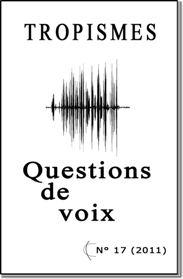Voix et conformismes, conformité de la voix
Keywords:
Voice, Impérative mode, Refrain, Yeats, William Butler, Muldoon, Paul, AutobiographyAbstract
Paul Muldoon's Moy Sand and Gravel (2002) ends with the long poem entitled 'At the Sign of the Black Horse, September 1999' in which individual and collective voices mingle for a while, during the flood caused by Hurricane Floyd. Voices from beyond the grave – the traces of religious or family legacies, blent with Yeats's literary heritage – give various orders, that are refused or accepted by the poet's singular voice, in a combination of repetitions, variations and humour. The question of the poet's singularity comes to the fore, considered in its tension with an alienating collective speech. Choosing to evoke Fanny Brice, the famous Jewish singer, is another means for Muldoon to tackle the relationship between popular old tunes and singular voices, refusing the Romantic myth of a poet embodied by his inspired voice; here, the poet's voice stands in the margins, playing ventriloquists and using autobiographical references, blurring both the sources of enunciation and the addressees of these discourses.
Published
Issue
Section
License
- Work submitted for publication must be original, previously unpublished, and not under consideration for publication elsewhere. If previously published figures, tables, or parts of text are to be included, the copyright-holder's permission must have been obtained prior to submission.

